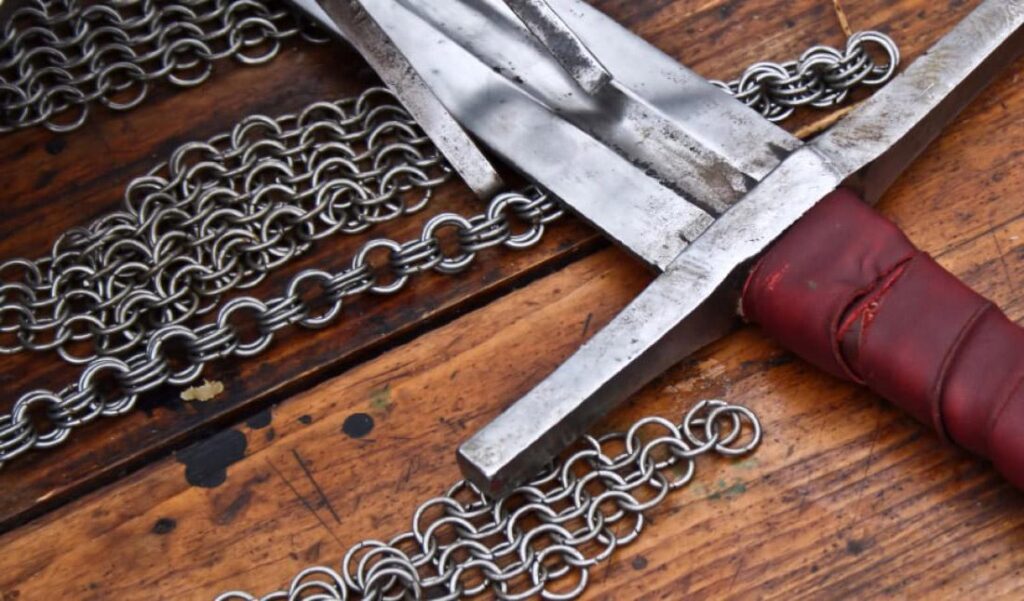Getting by with Minimal Gear

A question came up in a webinar once from an instructor in Indonesia about how to get by when minimal training equipment was available. This is a problem that many groups face if they’re in areas of the world where HEMA equipment is hard to import or expensive to acquire. But even for those who are lucky enough to be in North America, putting together a full stock of many swords and much protective equipment can be very prohibitive, especially at the beginning of your pursuit of the art.
In this clip I discuss some ways you can make the most of minimal equipment and a few strategies to consider to make your local dollar go further.
Use What You’ve Got
There is a lot you can do with a small amount of gear. I do much of my practice when I’m travelling with things that I have on hand like a stick, cane, or broomstick. So much of the art of Duello Armizare is about how you stand, move and hold your body. Any sword-like object can provide you with a tool for helping you form the shapes and coordinate the foundational movements between them.
Historically, training with wooden swords was common as they were cheaper and could also be intentionally heavier than a sword to facilitate greater conditioning.
Greg Reimer, here at Path of the Sword, put together this one- or two-handed sword trainer from a section of pipe and grip tape. All available at a local hardware store.

This article on the Academie Duello blog gives some simple instructions for putting together a more complex DIY two-handed sword trainer complete withe cross guard.
Be Aware of the Pretending
Our first tenet in Duello Armizare is “Proper Arms” which is the recognition that the weapon itself is your first teacher, and so the closer your simulator can be to the real thing the better. That being said, sometimes you have to make do.
The main drawback of using a sword-like-object is that it does not handle or interact with other swords in the same way that a properly weighted steel sword does. Yet it’s important to recognize that no matter how accurate your simulator is it is still that: a simulator. A dull edged sword is again not the same as a sharp one—yet it is a necessary conceit for the safety of our training partners.
The important thing is to become aware of the aspects of your training that require some “pretending” (understanding the artifacts) and to understand how that pretending might affect what works and does not in your practice. For example, the edges of two sharp swords bite into one another in a way that dull edges do not — be aware of that. A thicker wooden sword moves with different aerodynamic resistance than a tapered steel sword — be aware of that too. Use that awareness to better tailor your training.
Share the Gear You Have
If you have one steel sword in you group, share it around, at least for some solo training. When you can spend a little bit of time with more accurate simulators it can help you train more authentically with inaccurate simulators—essentially it can help you pretend a little better.
If you have only enough protective gear for two people in class, then that means you can have two people practice a drill with more intention (and protection from error), and the rest of the group managing the safety through a greater reduction in speed or even doing an exercise out of distance.
Don’t Rely on Protective Gear
At Academie Duello, though we have a ton of loaner gear, we still begin our training with minimal equipment. It allows people to get started much more easily and does not foster a false sense that gear can fully protect you. The more assured protection in any practice is the control of the participants.
Make developing control of your movements and your speed your first priority. Like playing a musical instrument you want to focus on rhythm and fidelity at slower speeds. As you gain a greater level of precision then gradually increase your speed.
Simple Protective Gear
With control, a little bit of protective gear can go a long way. At Academie Duello our slow speed sparring requirement is a fencing mask, throat protector, and gloves.
Nearly all martial arts that I have trained, including many weapons arts from China and the Philippines, practice set drills (those with limited variability) with no protective gear at all and focus purely on the development of control.
When you start practicing exercises that have some variability a good pair of safety goggles can go a long way to protecting the most sensitive part of your body, your eyes. Then, provided you keep moving slow, if you’re using a blunted sword or stick it’s quite difficult to cause any substantive injury.
Buy Local
There is a lot you can do to create local gear, especially when it comes to padded jackets, and rigid joint protection. Talk to your local metal, leather and plastics fabricators. Swords can also be locally fabricated but be aware that building a sword that won’t break in a dangerous way under pressure takes some real know-how and proper testing. Yet building a training sword for light- and medium-speed drilling can quite easily be done, and indeed has been done at HEMA clubs throughout the world since before today’s beautiful training swords became widely available.
However you approach the question of equipment in your club, train responsibly and with consent. Get guidance from those who have more experience than you and when purchasing gear be sure to get it from reputable makers that have experience in the community whenever possible.
Take care and train safe!



